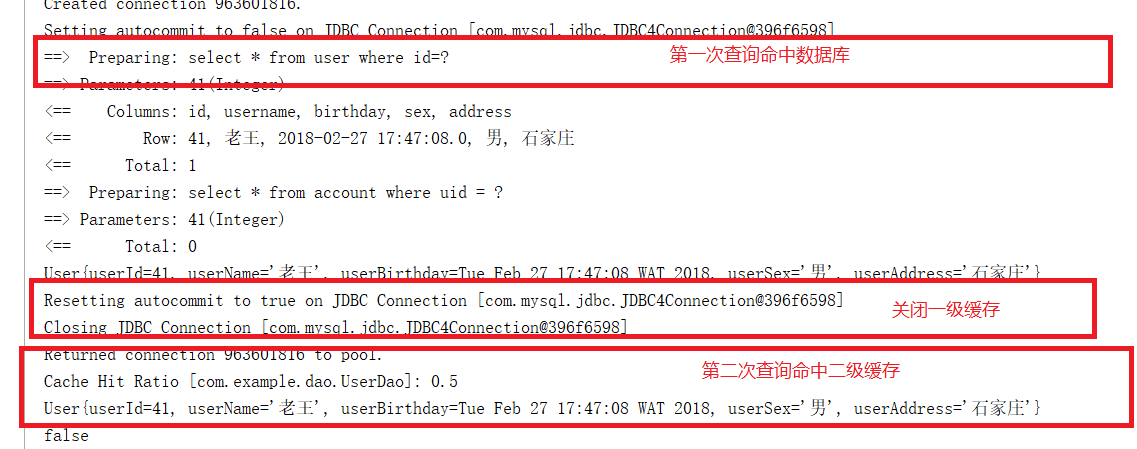Mybatis基于注解开启使用二级缓存
关于Mybatis的一级缓存和二级缓存的概念以及理解可以参照前面文章的介绍。前文连接:https://www.cnblogs.com/hopeofthevillage/p/11427438.html,上文中二级缓存使用的是xml方式的实现,本文主要是补充一下Mybatis中基于注解的二级缓存的开启使用方法。
1.在Mybatis的配置文件中开启二级缓存
- <?xml version="1.0" encoding="UTF-8" ?>
- <!DOCTYPE configuration
- PUBLIC "-//mybatis.org//DTD Config 3.0//EN"
- "http://mybatis.org/dtd/mybatis-3-config.dtd">
- <configuration>
- <settings>
- <!--开启全局的懒加载-->
- <setting name="lazyLoadingEnabled" value="true"/>
- <!--<!–关闭立即加载,其实不用配置,默认为false–>-->
- <!--<setting name="aggressiveLazyLoading" value="false"/>-->
- <!--开启Mybatis的sql执行相关信息打印-->
- <setting name="logImpl" value="STDOUT_LOGGING" />
- <!--默认是开启的,为了加强记忆,还是手动加上这个配置-->
- <setting name="cacheEnabled" value="true"/>
- </settings>
- <typeAliases>
- <typeAlias type="com.example.domain.User" alias="user"/>
- <package name="com.example.domain"/>
- </typeAliases>
- <environments default="test">
- <environment id="test">
- <!--配置事务-->
- <transactionManager type="jdbc"></transactionManager>
- <!--配置连接池-->
- <dataSource type="POOLED">
- <property name="driver" value="com.mysql.jdbc.Driver"/>
- <property name="url" value="jdbc:mysql://localhost:3306/test1"/>
- <property name="username" value="root"/>
- <property name="password" value="123456"/>
- </dataSource>
- </environment>
- </environments>
- <mappers>
- <package name="com.example.dao"/>
- </mappers>
- </configuration>
开启缓存 <setting name="cacheEnabled" value="true"/>,为了查看Mybatis中查询的日志,添加 <setting name="logImpl" value="STDOUT_LOGGING" />开启日志的配置。
2.领域类以及Dao
- public class User implements Serializable{
- private Integer userId;
- private String userName;
- private Date userBirthday;
- private String userSex;
- private String userAddress;
- private List<Account> accounts;
- 省略get和set方法......
- }
- import com.example.domain.User;
- import org.apache.ibatis.annotations.*;
- import org.apache.ibatis.mapping.FetchType;
- import java.util.List;
- @CacheNamespace(blocking = true)
- public interface UserDao {
- /**
- * 查找所有用户
- * @return
- */
- @Select("select * from User")
- @Results(id = "userMap",value = {@Result(id = true,column = "id",property = "userId"),
- @Result(column = "username",property = "userName"),
- @Result(column = "birthday",property = "userBirthday"),
- @Result(column = "sex",property = "userSex"),
- @Result(column = "address",property = "userAddress"),
- @Result(column = "id",property = "accounts",many = @Many(select = "com.example.dao.AccountDao.findAccountByUid",fetchType = FetchType.LAZY))
- })
- List<User> findAll();
- /**
- * 保存用户
- * @param user
- */
- @Insert("insert into user(username,birthday,sex,address) values(#{username},#{birthday},#{sex},#{address})")
- void saveUser(User user);
- /**
- * 更新用户
- * @param user
- */
- @Update("update user set username=#{username},birthday=#{birthday},sex=#{sex},address=#{address} where id=#{id}")
- void updateUser(User user);
- /**
- * 删除用户
- * @param id
- */
- @Delete("delete from user where id=#{id}")
- void deleteUser(Integer id);
- /**
- * 查询用户根据ID
- * @param id
- * @return
- */
- @Select("select * from user where id=#{id}")
- @ResultMap(value = {"userMap"})
- User findById(Integer id);
- /**
- * 根据用户名称查询用户
- * @param name
- * @return
- */
- // @Select("select * from user where username like #{name}")
- @Select("select * from user where username like '%${value}%'")
- List<User> findByUserName(String name);
- /**
- * 查询用户数量
- * @return
- */
- @Select("select count(*) from user")
- int findTotalUser();
- }
3.在对应的Dao类上面增加注释以开启二级缓存
@CacheNamespace(blocking = true)
4.测试
- public class UserCacheTest {
- private InputStream in;
- private SqlSessionFactory sqlSessionFactory;
- @Before
- public void init()throws Exception{
- in = Resources.getResourceAsStream("SqlMapConfig.xml");
- sqlSessionFactory = new SqlSessionFactoryBuilder().build(in);
- }
- @After
- public void destory()throws Exception{
- in.close();
- }
- @Test
- public void testFindById(){
- //第一查询
- SqlSession sqlSession1 = sqlSessionFactory.openSession();
- UserDao userDao1 = sqlSession1.getMapper(UserDao.class);
- User user1 = userDao1.findById(41);
- System.out.println(user1);
- //关闭一级缓存
- sqlSession1.close();
- //第二次查询
- SqlSession sqlSession2 = sqlSessionFactory.openSession();
- UserDao userDao2 = sqlSession2.getMapper(UserDao.class);
- User user2 = userDao2.findById(41);
- System.out.println(user2);
- sqlSession1.close();
- System.out.println(user1 == user2);
- }
- }
- (1)未开启二级缓存时

- (2)开启二级缓存时

Mybatis基于注解开启使用二级缓存的更多相关文章
- 基于Spring Cache实现二级缓存(Caffeine+Redis)
一.聊聊什么是硬编码使用缓存? 在学习Spring Cache之前,笔者经常会硬编码的方式使用缓存. 我们来举个实际中的例子,为了提升用户信息的查询效率,我们对用户信息使用了缓存,示例代码如下: @A ...
- SpringMVC + ehcache( ehcache-spring-annotations)基于注解的服务器端数据缓存
背景 声明,如果你不关心java缓存解决方案的全貌,只是急着解决问题,请略过背景部分. 在互联网应用中,由于并发量比传统的企业级应用会高出很多,所以处理大并发的问题就显得尤为重要.在硬件资源一定的情况 ...
- 阶段3 1.Mybatis_12.Mybatis注解开发_8 mybatis注解开发使用二级缓存
执行两次都查询userId为57的数据.测试一级缓存 返回true 新建测试类 ,测试二级缓存 二级缓存的配置 首先是全局配置,不配置其实也是可以的.默认就是开启的.这里为了演示配置上 dao类里面进 ...
- MyBatis功能点一:二级缓存cache
对于Mybatis缓存分作用域等维度区别一.二级缓存特点如下图: 分析缓存源码首先得找到缓存操作的入口:前面已经分析,sqlsesion.close()仅对一级缓存有影响,而update等对一/二级缓 ...
- mybatis plus使用redis作为二级缓存
建议缓存放到 service 层,你可以自定义自己的 BaseServiceImpl 重写注解父类方法,继承自己的实现.为了方便,这里我们将缓存放到mapper层.mybatis-plus整合redi ...
- Spring+Mybatis基于注解整合Redis
基于这段时间折腾redis遇到了各种问题,想着整理一下.本文主要介绍基于Spring+Mybatis以注解的形式整合Redis.废话少说,进入正题. 首先准备Redis,我下的是Windows版,下载 ...
- SpringMvc+Spring+MyBatis 基于注解整合
最近在给学生们讲Spring+Mybatis整合,根据有的学生反映还是基于注解实现整合便于理解,毕竟在先前的工作中团队里还没有人完全舍弃配置文件进行项目开发,由于这两个原因,我索性参考spring官方 ...
- Mybatis 源码分析之一二级缓存
一级缓存 其实关于 Mybatis 的一级缓存是比较抽象的,并没有什么特别的配置,都是在代码中体现出来的. 当调用 Configuration 的 newExecutor 方法来创建 executor ...
- java基于注解的redis自动缓存实现
目的: 对于查询接口所得到的数据,只需要配置注解,就自动存入redis!此后一定时间内,都从redis中获取数据,从而减轻数据库压力. 示例: package com.itliucheng.biz; ...
随机推荐
- postgresql集群的搭建
目录 架构图 部署详情 postgresql的安装与配置 pgpool的安装与配置 写在安装前 postgresql是一款很强大的数据库,具体有多强大呢,请谷歌... 网上的相关资料不是很多,参考了大 ...
- Java ——修饰符 包 Bean
本节重点思维导图 Bean 是一个类,类中所有的属性都是私有化的,所有的属性都有相应的getter/setter方法 对于boolean类型的成员变量来说,它的getter方法是:isXxxx() 详 ...
- Android安全测试(二)反编译检测
1.测试环境 SDK: Java JDK, Android SDK. 工具: 7zip, dex2jar, jd-gui 2.操作步骤 第一步:把apk改后缀名为zip 第二步:将zip文件解压,得到 ...
- java高级开发面试总结
Java高级工程师面试题总结及参考答案 (转载)博客原文链接:https://www.cnblogs.com/java1024/p/8594784.html 一.面试题基础总结 1. JVM结构原理. ...
- Greg and Array CodeForces 296C 差分数组
Greg and Array CodeForces 296C 差分数组 题意 是说有n个数,m种操作,这m种操作就是让一段区间内的数增加或则减少,然后有k种控制,这k种控制是说让m种操作中的一段区域内 ...
- SQLServer查看及设置最大连接数
很多时候自己本地开发会遇到 ,打开几个连接正常访问 之后就报错误,这时候需要调整sqlserver 最大连接数. 1. 查询最大连接数 SELECT value_in_useFROM sys.conf ...
- 前端:HTML5和CSS3新特性一览
转载:https://www.cnblogs.com/star91/p/5659134.html
- CentOS7搭建Docker镜像实战
开发十年,就只剩下这套架构体系了! >>> 一.搭建环境 使用的是VMWare 12虚拟机安装的CentOS7 安装成功后修改ip: 1. ip addr查看相关信息: 2. 修 ...
- js中的函数声明置顶
函数声明置顶是指 js引擎在读取变量与声明式函数时,会优先读取,例如如下 var a = 1: function a(){}; console.log(a); //这里得到的为1,而不是该functi ...
- 读取FTP上的excel文件,并写入数据库
今天遇到一些问题,需要从ftp上读取一些excel文件,并需要将excel中的数据写入到数据库,这样就可以通过管理页面查看这些数据. 我将相关工作分为三步,1.从ftp上读取相关文件,并将excel文 ...
